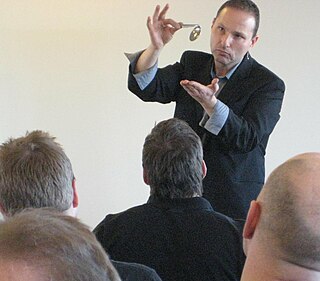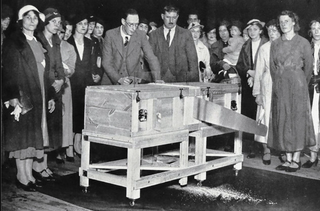
The cups and balls is a performance of magic with innumerable adaptations. Street gambling variations performed by conmen were known as Bunco Booths. A typical cups and balls routine includes many of the most fundamental effects of magic: the balls can vanish, appear, transpose, reappear and transform. Basic skills, such as misdirection, manual dexterity, sleight of hand, and audience management are also essential to most cups and balls routines. As a result, mastery of the cups and balls is considered by many as the litmus test of a magician's skill with gimmick style tricks. Magician John Mulholland wrote that Harry Houdini had expressed the opinion that no one could be considered an accomplished magician until he had mastered the cups and balls. Professor Hoffman called the cups and balls "the groundwork of all legerdemain".
Sleight of hand refers to fine motor skills when used by performing artists in different art forms to entertain or manipulate. It is closely associated with close-up magic, card magic, card flourishing and stealing. Because of its heavy use and practice by magicians, sleight of hand is often confused as a branch of magic; however, it is a separate genre of entertainment and many artists practice sleight of hand as an independent skill. Sleight of hand pioneers with worldwide acclaim include Dan and Dave, Ricky Jay, Derek DelGaudio, David Copperfield, Yann Frisch, Norbert Ferré, Dai Vernon, Cardini, Tony Slydini and Helder Guimarães.

Coin magic is the manipulating of coins to entertain audiences. Because coins are small, most coin tricks are considered close-up magic or table magic, as the audience must be close to the performer to see the effects. Though stage conjurers generally do not use coin effects, coin magic is sometimes performed onstage using large coins. In a different type of performance setting, a close-up coin magician will use a large video projector so the audience can see the magic on a big screen. Coin magic is generally considered harder to master than other close-up techniques such as card magic, as it requires great skill and grace to perform convincingly, and this requires much practice to acquire.
A trick deck usually refers to a deck of playing cards that has been altered in some way to allow magicians to perform certain card tricks where sleight of hand would be too difficult or impractical.

Spoon bending is the apparent deformation of objects, especially metal cutlery, purportedly by paranormal means. It is a common theme for magic tricks, which use a variety of methods to produce the effect. Performers commonly use misdirection to draw their audience's attention away while the spoon is manually bent. Another method uses a metal spoon that has been prepared by repeatedly bending the spoon back and forth, weakening the material. Applying light pressure will then cause it to bend or break.

Sawing a woman in half is a generic name for a number of stage magic tricks in which a person is apparently sawn or divided into two or more pieces.
The bullet catch is a stage magic illusion in which a magician appears to catch a bullet fired directly at them — often in the mouth, sometimes in the hand or sometimes caught with other items such as a dinner plate. The bullet catch may also be referred to as the bullet trick, defying the bullets or occasionally the gun trick.
Out of This World is a card trick created by magician Paul Curry in 1942. Many performers have devised their own variations of this trick. It is often billed as "the trick that fooled Winston Churchill" due to a story describing how it was performed for him during World War II. The method behind the trick is simple and essentially self-working, and can be enhanced by the presentation of the performer and the use of other principles of magic.

A thumb tip is a magician's prop designed to fit over and appear to be the magician's thumb used for vanishing, producing, or switching small objects. A classic effect is to have a silk handkerchief or other small object pressed into the top of the left fist. After pushing it well in with the right thumb, the left fist is opened to show the silk has disappeared. Alternatively, a lit cigarette, liquid, salt or other small objects can be made to disappear in a similar manner.
This is a glossary of conjuring terms used by magicians.
Glorpy, sometimes known as the Haunted Handkerchief, is a close-up magic trick. The effect is that a ghost or spirit is captured in a folded handkerchief that then makes the handkerchief move. This effect is also used in demonstrations of spirit writing when shown in a seance or mentalism context. Simple versions have been performed for years. A modern version by Bill Madden and Bernie Trueblood was created circa 1960 and declared the "Trick of the Millennium" by Genii, the conjurer's magazine.
In the art of conjuring, lapping refers to a set of techniques whereby a performer seated at a table can secretly dispose of an item into their lap. A common lapping technique is to sweep an item into the lap while pretending to pick it off the tabletop.
Platform magic is magic that is done for larger audiences than close-up magic and for smaller audiences than stage magic. It is more intimate than stage magic because it doesn't require expensive, large-scale stage equipment and can thus be performed closer to the audience and without a stage. Many of the tricks performed by platform magicians are sufficiently angle-sensitive as to make them impossible to perform as micromagic. Most working magicians are parlor/platform magicians.

Magic, which encompasses the subgenres of illusion, stage magic, and close up magic, among others, is a performing art in which audiences are entertained by tricks, effects, or illusions of seemingly impossible feats, using natural means. It is to be distinguished from paranormal magic which are effects claimed to be created through supernatural means. It is one of the oldest performing arts in the world.

Emil Jarrow was a sleight of hand magician. He sometimes referred to himself humorously as a "prestidigitator." Jarrow was perhaps best known for creating the “lemon trick,” in which he would procure paper money from an apparently fresh lemon.
The reveal is a plot device in narrative structure, and is the exposure to the reader or audience of a previously unseen key character or element of plot or of the performance.
The Inexhaustible Bottle is a classic magic trick performed by stage magicians. It dates to the 17th century and has since inspired many variations; well known examples include Any Drink Called For, The Bar Act, Satan's Barman, and Think-a-Drink. During the temperance movement it became The Obliging Tea Kettle, and the modern Magic Tea Kettle remains a common prop available at most magic stores. A slight variation is the Magic Funnel. Today the trick is normally performed for children, although some stand-up shows retain a variation.

A levitation illusion is one in which a magician appears to defy gravity by making an object or person float in the air. The subject may appear to levitate unassisted, or it may be performed with the aid of another object in which case it is termed a "suspension".
The Rising Card is a popular category of magical illusion in which the magician causes randomly selected playing cards to spontaneously rise from the center of a deck. Many variations of this trick exist and are performed widely. The effect can be accomplished using a variety of methods and techniques, ranging from pure sleight of hand to complex electronic and mechanical solutions.







